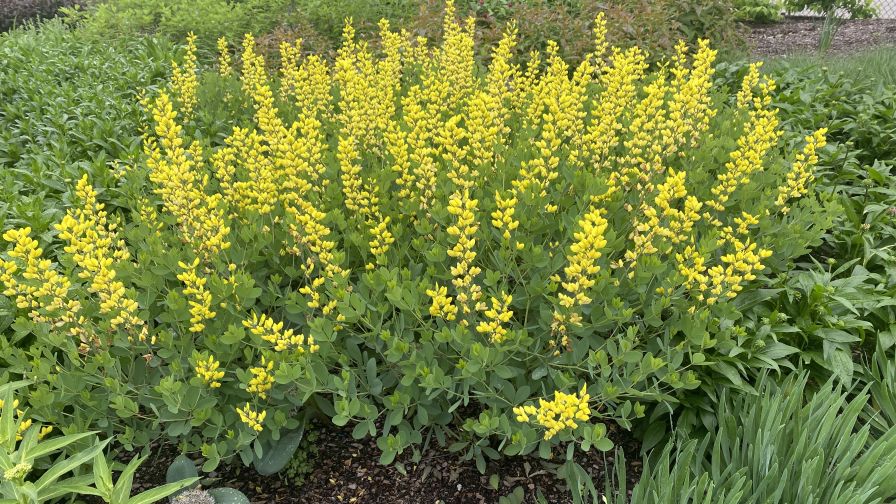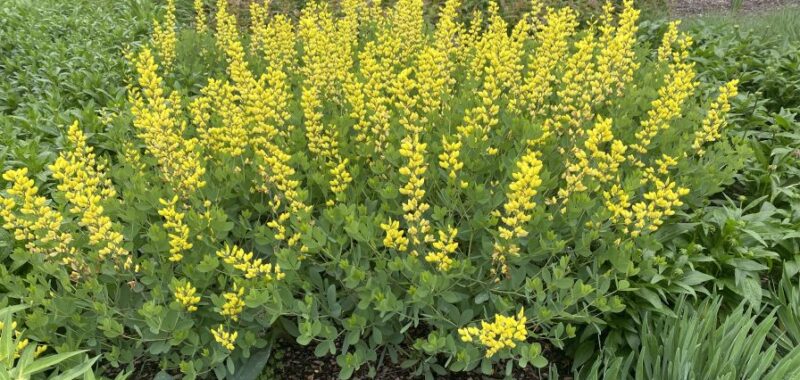
Baptisia are a Trifecta plant because they attract pollinators, they are deer-resistant, and are native to North America. Photo: Allan Armitage
A few columns ago, I wrote about a concept that allows us to separate the perceived value of some plants from others. I have been musing for years about the fact that plants are seldom bought (or used) simply because they are new or pretty. They must also solve a problem or fulfill a need.
I called this ‘solution gardening’ and that concept has been well embraced. However, the more I talk with retailers, landscapers, garden friends, and the No. 1 barometer of plant usefulness, my daughters, some of the latest trends have become much more marketable than others.
The Basics: To be an easy plant to market, it must perform. Regardless of beauty or bench value, if it poops out after temperatures warm up or cool down, it is history. Color is king — that’s why our plants sell, but we cannot continue to market a plant that disappoints. We know we can market plants on the tried-and-true premise that they work in heavy shade or the back forty. That’s the easy part. In the last dozen or so years, fashions have come and gone, but my daughters are adamant that all plants must have at least two of the three characteristics that have been elevated to trend status.
The Trifecta: Deer resistance, pollinator magnets, and North American nativity are referred to as the Trifecta. For nearly all plant shoppers, residential landscapers, and gardeners, it is the first two they are most passionate about.
Unless you have your head in the sand, it is impossible not to hear the roar of frustration when deer devour our garden plants. The explosion of deer has totally overwhelmed new gardeners and veterans alike. As proof of this frustration, I was giving away beautiful plants the other day, and I heard “I’ll take anything the deer won’t eat.” Even when the plants are free, the deer win. Market plants that are deer-resistant — there are many of them.
The second is the attraction of pollinators, particularly butterflies, to their purchases. Plants known for their attraction to pollinators are easy to market. Plants that are both deer-resistant and butterfly draws sell themselves.
I am not a fan of the third leg of this tripod, nativity — but it is real. Even my daughters concede that if they can get the first two characteristics, then nativity is just a bonus. One of the real downsides of being a native fanatic is that you eliminate 95% of all the annuals we sell — that is not a particularly good marketing strategy. However, if you have plants that are native, attract pollinators, and are deer-resistant, you have hit the Trifecta — and such plants can be easily marketed.
Here are a few examples of the Trifectas:
- Baptisia: Way underused, also provides spectacular color and performance.
- Monarda: Also provides wonderful fragrance and newer introductions are far more disease resistant.
- Amsonia: Two magnificent species, even with fall color.
- Summer phlox: If you are not touting this native as a winner of the trifecta, you are missing the boat.
- Agastache: Also provided fragrance and better performance than ever before.
Two out of three isn’t bad. Here are some deer-resistant pollinator plants:
- Salvia: Attracts every pollinator, no deer — every imaginable shape, size, and color.
- Achillea: Yarrows are unsung pollinators, deer don’t like them, and they make excellent cut flowers.
- Fennel: These are also fragrant, and absolute magnets for black swallowtail butterflies.
- Buddleia: As its common name suggests, butterfly bush is a no-brainer.
Quality, service, availability, consistency, and performance, to say nothing of color, will always trump any real or perceived plant trend. However, we agreed years ago that new is important. New does not only pertain to new plants but also to new trends and attracting new customers. If the Trifecta works for you, give it a squeeze and see what comes out.

